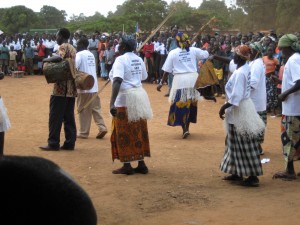
The Kakwa live in the extreme north west of Uganda. They occupy the Koboko county of Arua district. Ethically, the Kakwa are plain Nilotes, which means that they are of Kushitic descent.
Origins
There are two main traditions concerning the origins of the Kakwa.
One piece of tradition asserts that the ancestor of the Kakwa of Uganda was Yeki. He is said o have migrated from Karobe hill, southern Sudan and settled on Mt. Liru in Koboko. Here, Yeki is said to have produced seven sons and one of them was found of biting his brothers. For this reason, Yeki is said to have nicknamed him Kakwan ji, meaning biter. The descendants of Yeki are said to have adapted the plural term and called themselves Kakwa.
The second tradition claims that the Kakwa were originally known as Kui. The Kui are said to have been fierce fighters who inflicted heavy losses on their enemies. For this reason n the Kui are said to have nicknamed themselves Kakwa because their fierce attacks were like a bite of a tooth. The majority of the Kakwa in Koboko cling firmly to this tradition.
Virtually all the Kakwa clans in the whole of Koboko, part of Maracha and Aringa trace their origin to Loloyi but none of them can tell what or where exactly Loloyi is. By linguistic connection, the Kakwa can trace to the Bari of southern Sudan. Indeed the Kakwa still believe that they have connections with the Kuku, Mundari, Nyangwar, Pojuru and even Karimojong.
The Koboko tradition claims that the first Kakwa ancestors came form the direction of Ethiopia. This tradition does not state, however, the point at which the Kakwa separated form the Bari. The general conjecture is that they split o the Bari County east of the Nile. Given that they are plain Nilotics like the Iteso and the Karimojong, they might have separated from the Bari at Kapoeta.
Social and Political set-up
The political institutions of the Kakwa were segmentary. They had no centralized system of government and the clan was the basic social and political unit. Each clan was politically independent of others and it enjoyed sufficient traditional loyalty.
At the head of each clan there was a chief known as matter. Other clans referred to the chief as Buratyo; and others Ba Ambogo. The highest political officer was the chief and immediately below him were the clan elders known as Temejik. The Temejik were more often than not, heads of sub-clans and were related to the chief, being brothers or uncles.
The chief was both a political figure and a rainmaker. The Kakwa of Koboko still admit that rainmakers among them had been chiefs. Chieftainship was confined to the rainmaking clans and the chief would simultaneously assume two titles as chief of the land and chief of the rain.
Nevertheless, there were some Kakwa clans which did not have rainmakers. An example was Ludara Kakwa. They gave the reason that their ancestor Solo, did not belong to a rainmaking family. In such clans the duties of the chief of the land and the chief of the rain were separated. That of the chief of the rain was entrusted to another person who was not the chief. However, it was rare to find a chief who was not also a rainmaker.
The Kakwa society was matrilineal and the position of the chief was hereditary. However, among the non-rainmaking clans, the chief’s office was not hereditary. Clans without rainmakers could borrow them form other clans and a borrowed rainmaker did not have political influence. He would instead be paid for his services.
Clientship
There were no distinct classes among the Kakwa but the society contained the upper and the lower people. The lower people constituted the house servants, cattle herders, and young children.
If an upper class person looked after such dependants well, they would remain with him even after they married. However, if a client was treated in a hostile manner which made him look subservient, such a client would leave and look for another master. A client would normally leave and go somewhere else if he was referred to as monyatio meaning: stranger in the home”. Whenever a client attained marriageable age, he would have his bridewealth paid for him by his master. Thereafter, he would become part of the family.
Choosing and installing a chief.
Before a person could assume chieftainship, he had to perform some form of traditional ritual. Normally, a chief had a secret bead which was passed onto him by his predecessors. The chief would often drop the bead in food without the knowledge of his sons and invite them to eat. The one who discovered the bead and gave it to his father would become the future successor. From then on, his father would make him carry his chiefly stick and stool wherever he went. He was further required to observe carefully what his father was doing In order to become acquainted with his future responsibilities. The elders had the powers to reject such a nominee if it was widely known that he was irresponsible. There were other ways of selecting a successor to chieftainship but this one tended to be the commonest.
If a chief had no sons, his closest relative would succeed him. If a chief died leaving a young son, a regent would be appointed to act in his place until the child came of age. Such a case occurred in Media in the late 1890’s. Chief Bongo died and his infant son Baba became the chief-elect. Meanwhile, his nephew, Ali Kenyi was appointed regent. Baba was unfortunate, however, because before he could assume his office effectively, the Belgians came. Ali Kenyi collaborated with them and retained the chair.
During the installation of the chief, all the clan members would gather at the chiefly house known as Kadina mata. They would bring food and beer and it was customary that the elders would sit alone and invoke the ancestral blessings to enable the new chief lead his people in peace and prosperity. Then there would follow dancing and rejoicing.
Role of the chief
The chief had to protect the hunting grounds of the clan against other clans and to advise his clan t prevent its cattle from grazing on the crops of other clans. It was his duty to shift his people away in time of danger and to negotiate for peace in the event of external aggression and defeat. Besides, he acted as an adviser to the council of elders. If he acted in his capacity as a rainmaker, he did not need advice from the elders. This was due to the belief that the power to make rain and perform fertility rites could not be possessed by a common man, elderly tough he might be.
Military
The chief had no standing army. However, each chieftainship had a military leader known as the Jokwe. Before mobilizing for war, the chief and the Jokwe would consult the elders and a ritual ceremony would be performed t seek communication form the clan’s ancestors about the military strength of the enemy clan.
The ritual consisted of drawing a circle on the ground and then tying a chicken to the center of it. The circumference of the circle would be labeled alternately with signs of either victory or defeat. The chicken in the center of the circle would then be slaughtered. If it died, near ‘defeat’, the chief would advise the entire clan not t go for war. He would proceed to negotiate for peace with the head of the enemy clan. If however, the chicken died near ‘victory’, the clan had to go for war, no matter how weak it was, because it was believed that the ancestral spirits would give them support and the strength to win.
In certain cases such as among the Leiko, the women would accompany their husbands to war. It is said that such women were not assailed during the war due to a belief that if a man killed a woman during the war, the ancestors would not like it and he would therefore fell a victim to his enemies much earlier than expected. The purpose of taking women t battle was for them to yell and encourage their husbands. They would also remove the causalities and the dead and hide them until the battle was over.
Judicial system
Disputes were settled by clan elders. The most serous of the cases would be referred to the chief. Women and children would not participate in passing judgment. However, unlike the Lugbara who would not allow the women and children to linger near the court, the Kakwa allowed them to attend. They were required to sit down and glisten but they were not expected to talk except if they were testifying as a witness.
Some serious cases were often difficult to judge. Serious cases included murder and adultery. If a man was caught committing adultery, would be killed outright and no one would raise a case against the murder. Similarly, there was no time of or judging a thief. He would be killed as they said, “in the manner foxes are killed “something similar to “mob justice”. The murder of a person form another clan would bring warfare between clans and the murdered person was not mourned until sufficient revenge had been effected.
If one killed a clan’s man, revenge was not approved of. The murderer would pay compensation of a cow or two. People often confessed frankly in the form “I killed a, b, c because of x, y, z. If the accused denied the charges, two tests would be carried out to prove him guilty or not guilty. In cases involving witch craft or poisoning, once the accused pleaded not guilty, the following procedures would be undertaken:
If a woman was accused of poisoning her husband and she denied it, she would be taken to the stream to prove her innocence. The woman’s clansmen and the relatives of the husband would also come to the stream. The woman would then be fed on jja or kuru (wild plant seeds) and asked to drink plenty of water.
If she was innocent she was expected to vomit all the water. But if indeed she had poisoned the husband, she would not vomit anything and it was said that her stomach would begin to swell. At that point, she would be killed by the relatives of the husband while her own clansmen looked on. If, however, she vomited the water, her relatives would come to her defense and if she was not compensated for this abuse, war could easily ensue between the two clans. The payment of a bull or a cow by the husband’s relatives would restore the woman’s reputation and bring things to order once again.
If a couple was caught having sex outside marriage, the boy would be held hostage until his people paid a ransom, usually a cow or four goats in lieu. Quite often, too, the boy would be forced t marry the girl. These were simple cases which could not lead to war between different clans.
Economy
The economy of the Kakwa was mainly subsistence agriculture but some families also practiced mixed farming. They kept cattle, goats, and sheep besides agriculture. Millet has always been their principal food crop followed by sorghum and a type of bean called burusu. These were the staple foods of the Kakwa. They have been supplemented by pawpaws, maize and cassava. Cassava is said to have come with the advent of the Belgians and the intrusion of the logo, an ethnic group from Zaire.Pawpaws are said to have been introduced by the British.
Millet, sorghum and burusu were traditionally sown in a laree field dug on a communal basis, known as vya or litika. Women figured less prominently in the economy of the Kakwa. Men dug the fields, sowed the seeds, tended the animals, built and repaired the houses. Women would remove the rubbish from the cultivated fields, would also clean and store the crops away in the granaries.
The women engaged actively in basket weaving, salt making and pottery. Salt was made from indigenous plants known as morubo and bukuli. These plants wound be burnt and then the ashes we re put in a container with many holes at the bottom; water would be poured on the ashes. The salty liquid would filter through the holes and out into another container at the bottom.
The Nyangaila clan specialized in iron smelting, making spears, knives, hoes and a variety of other iron implements. Wealth among the Kakwa was measured in terms of “how many granaries full of foodstuff” one had in one’s compound and the number of the livestock in one’s kraal. In the event of famine, and this was common, people would migrate t another area where there was plenty of food.

 Posted in
Posted in 

